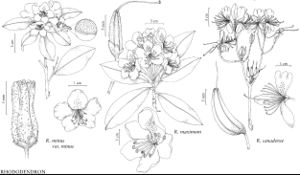Rhododendron minus
J. Hist. Nat. 1: 412. 1792 ,.
Shrubs, to 3(–5) mm, often rhizomatous. Stems: bark smooth to vertically furrowed, shredding; twigs with ferrugineous, multicellular, broad-rimmed, glandular-peltate scales. Leaves persistent; petiole with ferruginous, broad-rimmed, glandular-peltate scales and unicellular-hairy; blade narrowly elliptic to elliptic or oval, sometimes obovate, (1–)5–8(–13) × (1–)2–3.5(–5.5) cm, thick, coriaceous, margins entire, plane to conspicuously revolute, with scattered, glandular-peltate scales, apex acute or acuminate or obtuse to rounded, surfaces with scattered, ferruginous, broad-rimmed, glandular-peltate scales abaxially, (scales ± deciduous adaxially). Floral bud scales ferruginous-lepidote, sometimes also unicellular-hairy abaxially, margins unicellular-ciliate. Inflorescences 5–10-flowered; bracts similar to bud scales. Pedicels 5–15 mm, with ferruginous scales. Flowers opening before or after development of leaves, erect to horizontal, fragrant; calyx lobes 0.5–2 mm, with ferruginous scales; corolla dark to very pale pink or white, upper lobe usually with greenish spots, campanulate to funnelform, 15–37 mm, with scattered, ferruginous, peltate scales on outer surface, petals connate (for 3/4+ their lengths), lobes 8–19 mm, tube gradually expanding into lobes, 8–22 mm; stamens 10, included to slightly exserted, ± unequal, 13–26 mm. Capsules borne on erect pedicels, 6–14 × 2.9–5 mm, with ferruginous, peltate scales. Seeds with short, blunt/truncate tails at each end; testa closely appressed. 2n = 26.
Distribution

se United States.
Discussion
Varieties 2 (2 in the flora).
Rhododendron minus is here circumscribed broadly, including R. carolinianum and R. chapmanii, and the latter is considered to be a distinct variety (W. H. Duncan and T. M. Pullen 1962). Variety chapmanii is federally listed. This species is often grown as an ornamental.
Rhododendron minus and R. lapponicum are members of subg. Rhododendron, as indicated by their glandular-peltate scales; the subgenus is represented by hundreds of species in eastern and southern Asia (see J. Cullen 1980).
Selected References
None.
Key
| 1 | Leaf blades: apex usually acute or acuminate; petioles (5-)6-20 mm; branches not rigidly ascending. | Rhododendron minus var. minus |
| 1 | Leaf blades: apex usually rounded or obtuse; petioles 2-6(-7) mm; branches usually rigidly erect-ascending | Rhododendron minus var. chapmanii |
